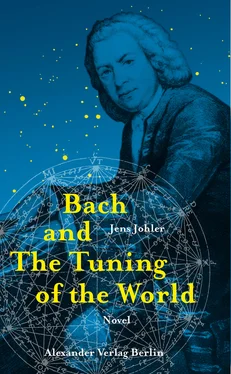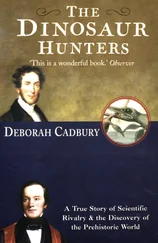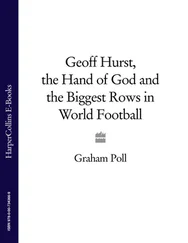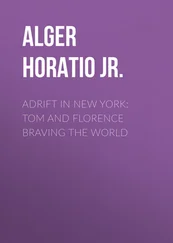‘In other words,’ said Bach, when they were walking through Am Berge Street and turned into Sandviertel, ‘we musicians are capable of influencing the souls of people mechanically , so to speak.’
‘Correct,’ said Erdmann. ‘Music has a magic power, Bach, you musicians are magicians of the soul.’
So Bach now had learned from Erdmann that music was capable, in a very natural or physical way, of affecting the soul. That same day, he learned from Georg Böhm the magical means that arouse different affections in the listener. ‘A musician has a plethora of means at his disposal,’ said Böhm, ‘an entire box of magic tricks, but, please, don’t misunderstand the term.’
The choice of key already has an impact, he explained. C major, for instance, is a radiant and brash key in which you can freely express your joy; C minor, on the other hand, is very sweet, sad as well, and there’s always a risk that it has a bit of a soporific effect. D major is sharp and stubborn by nature, he averred, suitable for composing noisy, funny and warlike things; D minor, by contrast, has something submissive and calm and can be used well for worship. And so on.
The choice of rhythm has as great an impact on the affections, he said. The three-part time measure, i.e. the three-quarter or six-eight time, always has something stormy and passionate about it; the two-part time measure, on the other hand, is calmer, more peaceful and serene, and naturally the tempo also plays a vital role: The slow and sostenuto tempo is solemn, sad, contemplative; the quick tempo is cheerful, has something of dance, laughter. The intervals, however, are of the greatest significance for the emotional effect of music: Large proportions close to the octave expand the animal spirits and make the mind cheerful; smaller proportions, by contrast, contract the spirits and induce emotions of sadness. The saddest is naturally the smallest interval, the semitone, and the saddest of all is the so-called passus duriusculus , the chromatic downward movement as an expression of the most painful and deepest grief. But that brought them to the doctrine of figures, Böhm said, which is a broad field.
‘What do you mean by musical figure?’ Bach asked, right at the beginning of the next lesson.
‘A figure,’ Böhm explained, ‘is a specific musical phrase, similar to idioms, exclamations or mottos in the spoken language. This is why the term tonal language has come into usage in recent times.’
Böhm had even created an entire catalogue of more than eighty figures. ‘And if I may give you a tip,’ he said to Bach, ‘then I advise you to compile your own catalogue, which you’ll need your whole life.’
So it came about that Bach started a collection of sheets on which he drew tables in his delicate, orderly hand. On the one side, he wrote words like ‘anabasis’, ‘aposiopesis’, ‘circulatio’ or ‘tirata’ and, on the other side, explanations in words and frequently using notes as well. For example, an anabasis was a gradually ascending melodic movement in a moderate tempo to represent something good, something pleasing; an aposiopesis was a pause that lent the musical moment great significance – to express death and eternity; a circulatio was a melodic movement circling around one note and indicating something round, a crown maybe or the Earth in its worldliness; and a tirata was an up- or downward scale at fast tempo to depict the movement of throwing, the stroke of a sword or of lightning. And these were only four out of over eighty of them. Bach learned them all, with great zealousness. And what he deemed useful, he put into his opera – the opera he did not say a single word about to his teacher.
They left school at Easter 1702. Thus the free board and lodging also ended. At least for Erdmann. Bach was granted an extension for two weeks, during which he was allowed to stay.
The day before Erdmann said goodbye, he presented Bach with the finished text. A parting gift, he said. Bach could do with it what he wanted. He could put his own name on it if he wanted; he himself no longer held any ambitions as an librettist.
He would never falsely take credit for anything, said Bach.
‘Well then,’ said Erdmann, ‘in that case, please use a pseudonym. Georgios Gaiandros.’
Bach promised.
‘By the way, I’m going to Halle,’ said Erdmann, ‘to study law with Christian Thomasius. Maybe you’d like to come with me?’
‘No,’ said Bach, ‘I’ll move to Hamburg and become an opera composer.’
Erdmann hugged him goodbye, kissed him and promised to write a letter every now and then.
Bach returned the embrace and promised to do the same.
Then they stood there indecisively, facing each other, and finally they embraced again.
‘How will you get to Halle?’ Bach asked. ‘On foot?’
‘No,’ said Erdmann. ‘The Prince is also travelling to Halle and will take me along in his carriage.’
The Prince was a student from the Knights’ School whom Erdmann had befriended some time ago. Perhaps because of this friendship, he had not worked quite as determinedly on the libretto as Bach had wished. But he’d got it done.
‘Well then,’ said Bach.
‘Yes,’ said Erdmann. ‘Well …’
They hugged each other for a third time, and that was it.
Erdmann departed, and Bach composed his opera, and finished it in a rapturous state. He wrote the overture last.
Конец ознакомительного фрагмента.
Текст предоставлен ООО «ЛитРес».
Прочитайте эту книгу целиком, купив полную легальную версию на ЛитРес.
Безопасно оплатить книгу можно банковской картой Visa, MasterCard, Maestro, со счета мобильного телефона, с платежного терминала, в салоне МТС или Связной, через PayPal, WebMoney, Яндекс.Деньги, QIWI Кошелек, бонусными картами или другим удобным Вам способом.












